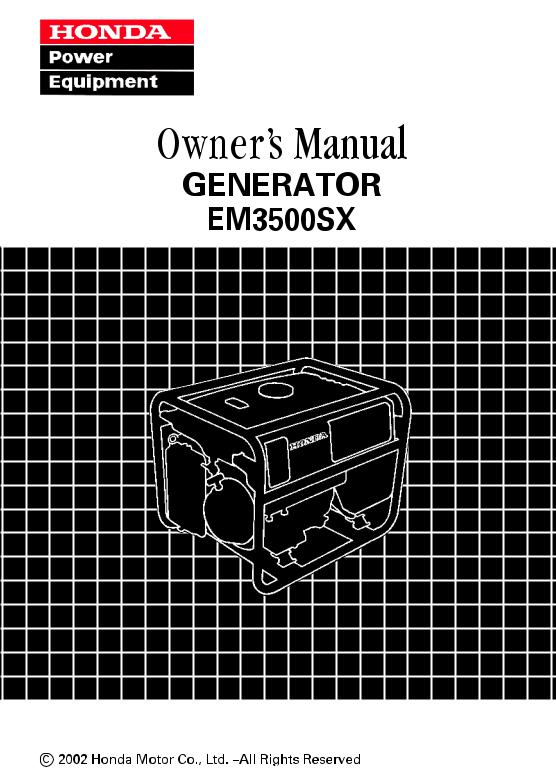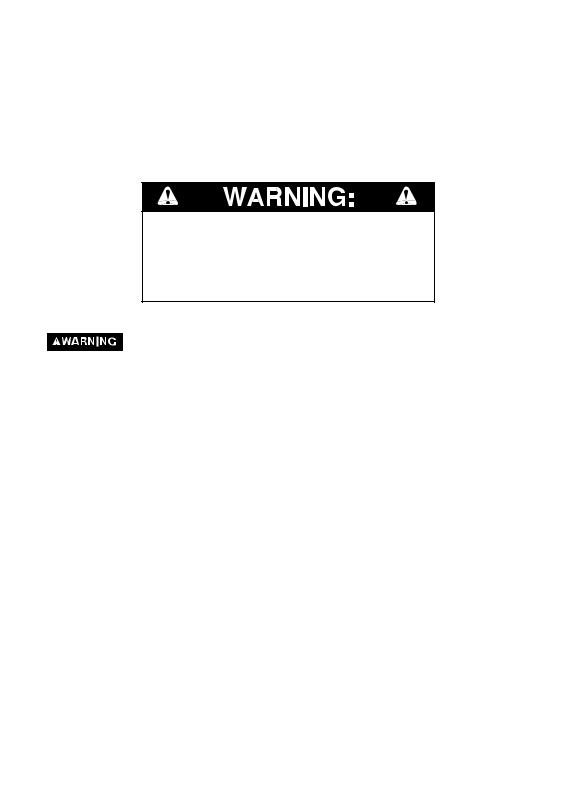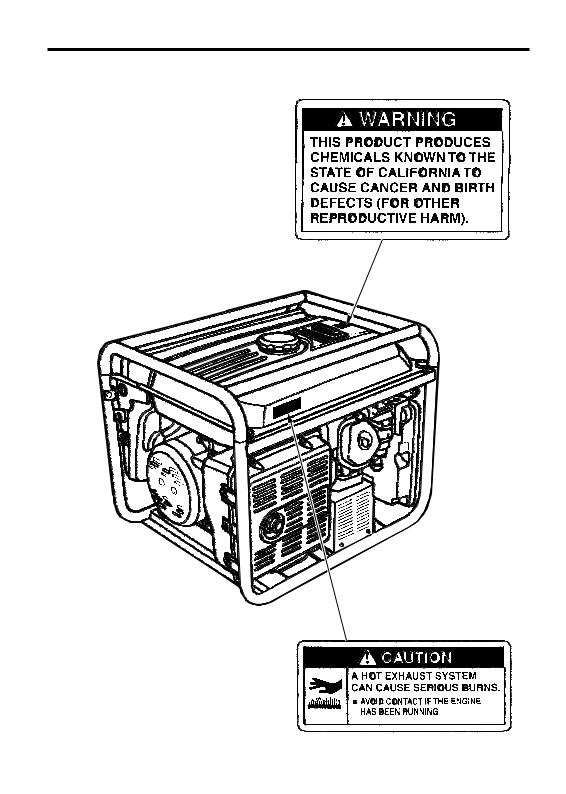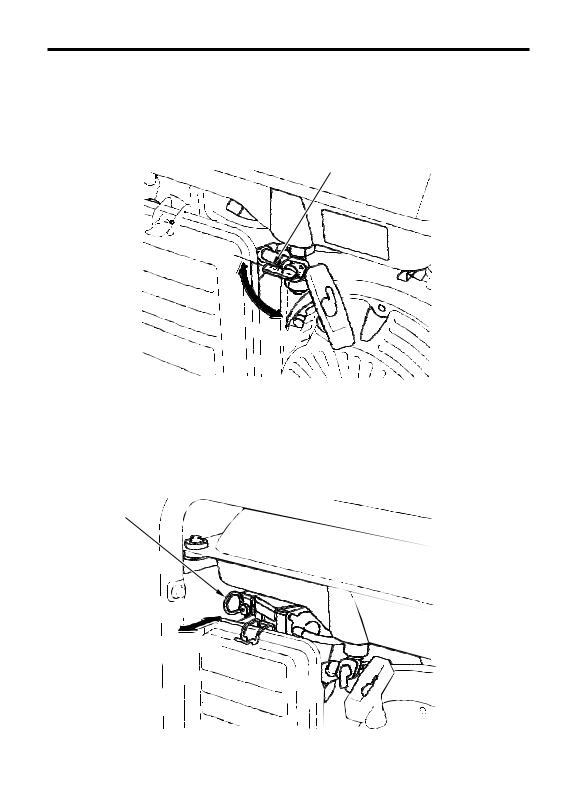Honda EM3500SX Owner's Manual


The engine exhaust from this product contains chemicals known to the State of California to cause cancer, birth defects or other reproductive harm.
The generator is a potential source of electrical shock if misused. Do not expose the generator to moisture, rain or snow. Do not let the generator get wet, and do not operate it with wet hands.
Keep this owner’s manual handy, so you can refer to it at any time. This owner’s manual is considered a permanent part of the generator and should remain with the generator if resold.
The information and specifications included in this publication were in effect at the time of approval for printing. Honda Motor Co., Ltd. reserves the right, however, to discontinue or change specifications or design at any time without notice and without incurring any obligation whatever. No part of this publication may be reproduced without written permission.

Congratulations on your selection of a Honda generator. We are certain you will be pleased with your purchase of one of the finest generators on the market.
We want to help you get the best results from your new generator and to operate it safely. This manual contains the information on how to do that; please read it carefully.
As you read this manual, you will find information preceded by a 




 symbol. That information is intended to help you avoid
symbol. That information is intended to help you avoid
damage to your generator, other property, or the environment.
We suggest you read the warranty policy to fully understand its coverage and your responsibilities of ownership. The warranty policy is a separate document that should have been given to you by your dealer.
When your generator needs scheduled maintenance, keep in mind that your Honda servicing dealer is specially trained in servicing Honda generators. Your authorized Honda servicing dealer is dedicated to your satisfaction and will be pleased to answer your questions and concerns.
Best Wishes,
Honda Motor Co., Ltd.
1

A FEW WORDS ABOUT SAFETY
Your safety and the safety of others are very important. And using this generator safely is an important responsibility.
To help you make informed decisions about safety, we have provided operating procedures and other information on labels and in this manual. This information alerts you to potential hazards that could hurt you or others.
Of course, it is not practical or possible to warn you about all the hazards associated with operating or maintaining a generator. You must use your own good judgement.
You will find important safety information in a variety of forms, including:
 Safety Labels on the generator.
Safety Labels on the generator.
 Safety Messages preceded by a safety alert symbol
Safety Messages preceded by a safety alert symbol  and one of three signal words, DANGER, WARNING, or CAUTION.
and one of three signal words, DANGER, WARNING, or CAUTION.
These signal words mean:
You WILL be KILLED or SERIOUSLY HURT if you don’t follow instructions.
You CAN be KILLED or SERIOUSLY HURT if you don’t follow instructions.
You CAN be HURT if you don’t follow instructions.
 Safety Headings such as IMPORT ANT SAF ET Y INF ORMAT ION.
Safety Headings such as IMPORT ANT SAF ET Y INF ORMAT ION.
 Safety Section such as GENERAT OR SAF ET Y .
Safety Section such as GENERAT OR SAF ET Y .
 Instructions how to use this generator correctly and safely.
Instructions how to use this generator correctly and safely.
This entire book is filled with important safety information please read it carefully.
2

|
CONTENTS |
SAFETY ...................................................................................................... |
. 5 |
SAFETY LABEL LOCATIONS .............................................................. |
. 5 |
SAFETY INFORMATION ..................................................................... |
. 7 |
COMPONENT IDENTIFICATION .............................................................. |
. 9 |
CONTROLS .............................................................................................. |
. 11 |
Engine Switch .................................................................................... |
. 11 |
Recoil Starter ..................................................................................... |
. 11 |
Fuel Valve Lever ................................................................................ |
. 12 |
Choke Rod .......................................................................................... |
. 12 |
Circuit Breaker ................................................................................... |
. 13 |
Circuit Protector ................................................................................ |
. 13 |
Ground Terminal ............................................................................... |
. 13 |
Oil Alert System .............................................................................. |
. 14 |
Auto-throttle System ........................................................................ |
. 14 |
Pilot Lamp .......................................................................................... |
. 15 |
Volt Meter .......................................................................................... |
. 15 |
Voltage Selector Switch (Dual Voltage System) ............................ |
. 15 |
DC Terminals ..................................................................................... |
. 16 |
DC Circuit Protector .......................................................................... |
. 16 |
GENERATOR USE ................................................................................... |
. 17 |
Connections to a Building Electrical System .................................. |
. 17 |
Ground System ................................................................................. |
. 17 |
AC Applications ................................................................................. |
. 18 |
AC Operation ..................................................................................... |
. 19 |
AC Receptacle Selection ................................................................... |
. 20 |
DC Operation ..................................................................................... |
. 21 |
Disconnecting the battery cables .................................................... |
. 22 |
Auto-throttle System ........................................................................ |
. 23 |
High Altitude Operation .................................................................... |
. 24 |
PRE-OPERATION CHECK ....................................................................... |
. 25 |
Engine Oil .......................................................................................... |
. 25 |
Fuel Recommendation ..................................................................... |
. 26 |
STARTING THE ENGINE ........................................................................ |
. 29 |
STOPPING THE ENGINE ........................................................................ |
. 30 |
3

MAINTENANCE ....................................................................................... |
31 |
The Importance of Maintenance ....................................................... |
31 |
Maintenance Safety ........................................................................... |
32 |
Emission Control System Information ............................................. |
33 |
Air Index .............................................................................................. |
36 |
Maintenance Schedule ...................................................................... |
37 |
Engine Oil Change ............................................................................. |
38 |
Air Cleaner Service ............................................................................ |
39 |
Fuel Sediment Cup Cleaning ............................................................ |
40 |
Spark Plug Service ............................................................................. |
41 |
Spark Arrester Maintenance ............................................................. |
42 |
TRANSPORTING/STORAGE ................................................................... |
43 |
TROUBLESHOOTING .............................................................................. |
45 |
WIRING DIAGRAM .................................................................................. |
47 |
SPECIFICATIONS ..................................................................................... |
48 |
INSTALLATION OF OPTIONAL PARTS .................................................. |
49 |
WARRANTY SERVICE INFORMATION .................................................. |
55 |
INDEX ....................................................................................................... |
56 |
4

SAFETY
SAFETY LABEL LOCATIONS
These labels warn you of potential hazards that can cause serious injury. Read them carefully.
If a label comes off or becomes hard to read, contact your Honda generator dealer for a replacement.
5

6

SAFETY INFORMATION
Honda generators are designed to give safe and dependable service if operated according to instructions. Read and understand this owner’s manual before operating your generator. You can help prevent accidents by being familiar with your generator’s controls, and by observing safe operating procedures.
Operator Responsibility
 Know how to stop the generator quickly in case of emergency.
Know how to stop the generator quickly in case of emergency.
 Understand the use of all generator controls, output receptacles, and connections.
Understand the use of all generator controls, output receptacles, and connections.
 Be sure that anyone who operates the generator receives proper instruction. Do not let children operate the generator without parental supervision.
Be sure that anyone who operates the generator receives proper instruction. Do not let children operate the generator without parental supervision.
Carbon Monoxide Hazards
 Exhaust contains poisonous carbon monoxide, a colorless and odorless gas. Breathing exhaust can cause loss of consciousness and may lead to death.
Exhaust contains poisonous carbon monoxide, a colorless and odorless gas. Breathing exhaust can cause loss of consciousness and may lead to death.
 If you run the generator in an area that is confined, or even partially enclosed, the air you breathe could contain a dangerous amount of exhaust gas. To keep exhaust gas from accumulating, provide adequate ventilation.
If you run the generator in an area that is confined, or even partially enclosed, the air you breathe could contain a dangerous amount of exhaust gas. To keep exhaust gas from accumulating, provide adequate ventilation.
7

Electric Shock Hazards
 The generator produces enough electric power to cause a serious shock or electrocution if misused.
The generator produces enough electric power to cause a serious shock or electrocution if misused.
 Using a generator or electrical appliance in wet conditions, such as rain or snow, or near a pool or sprinkler system, or when your hands are wet, could result in electrocution. Keep the generator dry.
Using a generator or electrical appliance in wet conditions, such as rain or snow, or near a pool or sprinkler system, or when your hands are wet, could result in electrocution. Keep the generator dry.
 If the generator is stored outdoors, unprotected from the weather, check all electrical components on the control panel, before each use. Moisture or ice can cause a malfunction or short circuit in electrical components which could result in electrocution.
If the generator is stored outdoors, unprotected from the weather, check all electrical components on the control panel, before each use. Moisture or ice can cause a malfunction or short circuit in electrical components which could result in electrocution.
 Do not connect to a building electrical system unless an isolation switch has been installed by a qualified electrician.
Do not connect to a building electrical system unless an isolation switch has been installed by a qualified electrician.
Fire and Burn Hazards
 The exhaust system gets hot enough to ignite some materials.Keep the generator at least 3 feet (1 meter) away from buildings
The exhaust system gets hot enough to ignite some materials.Keep the generator at least 3 feet (1 meter) away from buildings
and other equipment during operation.
Do not enclose the generator in any structure.Keep flammable materials away from the generator.
 The muffler becomes very hot during operation and remains hot for a while after stopping the engine. Be careful not to touch the muffler while it is hot. Let the engine cool before storing the generator indoors.
The muffler becomes very hot during operation and remains hot for a while after stopping the engine. Be careful not to touch the muffler while it is hot. Let the engine cool before storing the generator indoors.
 Gasoline is extremely flammable and is explosive under certain conditions. Do not smoke or allow flames or sparks where the generator is refueled or where gasoline is stored. Refuel in a wellventilated area with the engine stopped.
Gasoline is extremely flammable and is explosive under certain conditions. Do not smoke or allow flames or sparks where the generator is refueled or where gasoline is stored. Refuel in a wellventilated area with the engine stopped.
 Fuel vapors are extremely flammable and may ignite after the engine has started. Make sure that any spilled fuel has been wiped up before starting the generator.
Fuel vapors are extremely flammable and may ignite after the engine has started. Make sure that any spilled fuel has been wiped up before starting the generator.
8

COMPONENT IDENTIFICATION
VOLT METER
ENGINE SWITCH
CHOKE ROD
FUEL
VALVE
LEVER
AIR
CLEANER
RECOIL
STARTER
GRIP
DC CIRCUIT
PROTECTOR
DC OUTPUT
TERMINAL
PILOT LAMP
VOLTAGE SELECTOR SWITCH
AC CIRCUIT BREAKER
AC CIRCUIT
PROTECTOR

 AC
AC
RECEPTACLES
GROUND TERMINAL
OIL FILLER CAP
AUTO-THROTTLE
SWITCH
OIL DRAIN PLUG
ENGINE SERIAL NUMBER
9

FUEL TANK CAP |
FUEL METER |
SPARK PLUG
CAP
FRAME SERIAL NUMBER
MUFFLER
*Record the engine and frame serial numbers for your future reference. Refer to these serial numbers when ordering parts, and when making technical or warranty inquiries (see page 55 ).
Frame serial number:
Engine serial number:
10

CONTROLS
ENGINE SWITCH
To start and stop the engine.
Key position:
OFF: To stop the engine. Key can be removed/inserted. ON: To run the engine after starting.
START: To start the engine by operating the starter motor.
ON
OFF
START
ENGINE SWITCH
Return the key to the ON position once the engine has started. Do not use the starter for more than 5 seconds at a time. If the engine fails to start, release the switch and wait 10 seconds before operating the starter again.
RECOIL STARTER
To start the engine, pull the starter grip lightly until resistance is felt, then pull briskly.
Do not allow the starter grip to snap back against the engine. Return it gently to prevent damage to the starter.
STARTER GRIP
11

FUEL VALVE LEVER
The fuel valve is located between the fuel tank and carburetor. When the valve lever is in the ON position, fuel is allowed to flow from the fuel tank to the carburetor. Be sure to return the fuel valve lever to the OFF position after stopping the engine.
FUEL VALVE LEVER
OFF
ON
CHOKE ROD
The choke is used to provide an enriched fuel mixture when starting a cold engine. It can be opened and closed by operating the choke rod manually. Pull the rod out toward CLOSED to enrich the mixture for cold starting.
CHOKE ROD
OPEN
CLOSED
12

CIRCUIT BREAKER
The AC circuit breaker will automatically switch OFF if there is a short circuit or an overload of the generator at the AC receptacle. If the AC circuit breaker is switched OFF automatically, check that the appliance is working properly and does not exceed the rated load capacity of the AC circuit before switching the AC circuit breaker ON again.
The AC circuit breaker may be used to switch the generator AC power ON or OFF.
CIRCUIT PROTECTOR
The circuit protectors will automatically switch OFF if there is a short circuit or a significant overload of the generator at the 120V 20A or 120/240V 20A locking plug receptacle. If a circuit protector switches OFF automatically, check that the appliance is working properly and does not exceed the rated load capacity of the circuit before resetting the circuit protector to the ON position.
GROUND TERMINAL
The generator ground terminal is connected to the frame of the generator, the metal non-current-carrying parts of the generator, and the ground terminals of each receptacle.
Before using the ground terminal, consult a qualified electrician, electrical inspector or local agency having jurisdiction for local codes or ordinances that apply to the intended use of the generator.
ON |
AC CIRCUIT BREAKER |
AC CIRCUIT PROTECTOR
OFF
ON
OFF
GROUND TERMINAL
13

OIL ALERT SYSTEM
SYSTEM
The Oil Alert system is designed to prevent engine damage caused by an insufficient amount of oil in the crankcase. Before the oil level in the crankcase can fall below a safe limit, the Oil Alert
system is designed to prevent engine damage caused by an insufficient amount of oil in the crankcase. Before the oil level in the crankcase can fall below a safe limit, the Oil Alert system will automatically stop the engine (the engine switch will remain in the ON position).
system will automatically stop the engine (the engine switch will remain in the ON position).
If the engine stops and will not restart, check the engine oil level (see page 25 ) before troubleshooting in other areas.
OIL FILLER HOLE |
UPPER |
|
LEVEL |
OIL FILLER CAP |
|
Auto-throttle System
The auto-throttle system automatically reduces engine speed when all loads are turned off or disconnected. When appliances are turned on or reconnected, the engine returns to the rated speed.
AUTO: Recommended to minimize fuel consumption and further reduce noise levels when no load is applied to the generator.
OFF: The auto-throttle system does not operate.
Recommended to minimize warm-up time when the generator is started.
AUTO
OFF
AUTO-THROTTLE
SWITCH
14

Pilot Lamp
The pilot lamp is illuminated when the generator is operating normally. It indicates that the generator is producing electrical power at the 120 or 120/240 volt receptacles. If the pilot light is illuminated, the volt meter should be displaying 120 or 240 volts depending on the position of the voltage selector switch.
When the auto-throttle is in the AUTO position, and there is no load connected to the generator, the engine will run slower and the pilot light will be dimmer than at normal operating speed.
Volt Meter
The volt meter displays the voltage the generator is producing depending on the position of the voltage selector switch. If the voltage selector switch is in the ‘‘120/240V’’ position, the volt meter will display 240 volts. If the voltage selector switch is in the ‘‘120V ONLY’’ position, the volt meter will display 120 volts.
VOLTAGE SELECTOR SWITCH (DUAL VOLTAGE SYSTEM)
The voltage selector switches the main power carrying windings of the generator to produce ‘‘120V ONLY’’ or ‘‘120/240V’’. If a 240V appliance is connected to the 4-prong receptacle, the switch must be in the ‘‘120/ 240V’’ position. If only a 120V appliance is being connected to any of the 120V 3-prong receptacles, select the ‘‘120V ONLY’’ position.
120/240V: The 120V and 120/240V receptacles can be used simultaneously.
120V ONLY: ONLY the 120V receptacles can be used. Do not use the 120/240V receptacle in this position. Rated power will be available at the 120V twist lock receptacle.
PILOT LAMP |
VOLTAGE SELECTOR |
|
SWITCH |
VOLT METER |
|
120V |
|
120 |
240V |
15

DC Terminals
The DC terminals may ONLY be used for charging 12 volt automotive type batteries.
The terminals are colored red to identify the positive ( ) terminal and black to identify the negative ( ) terminal. The battery must be connected to the generator DC terminals with the proper polarity (battery positive to generator red terminal and battery negative to the generator black terminal).
DC CIRCUIT PROTECTOR
The DC circuit protector automatically shuts off the DC battery charging circuit when the DC charging circuit is overloaded, when there is a problem with the battery, or when the connections between the battery and the generator are improper.
DC CIRCUIT
PROTECTOR
NEGATIVE TERMINAL |
POSITIVE TERMINAL |
(BLACK) |
(RED) |
16

GENERATOR USE
CONNECTIONS TO A BUILDING ELECTRICAL SYSTEM
Connections for standby power to a building electrical system must be made by a qualified electrician. The connection must isolate the generator power from utility power, and must comply with all applicable laws and electrical codes. A transfer switch, which isolates generator power from utility power, is available through authorized Honda generator dealers.
Improper connections to a building electrical system can allow electrical current from the generator to backfeed into the utility lines. Such backfeed may electrocute utility company workers or others who contact the lines during a power outage, and the generator may explode, burn, or cause fires when utility power is restored. Consult the utility company or a qualified electrician.
GROUND SYSTEM
Honda portable generators have a system ground that connects generator frame components to the ground terminals in the AC output receptacles. The system ground is not connected to the AC neutral wire. If the generator is tested by a receptacle tester, it will not show the same ground circuit condition as for a home receptacle.
SPECIAL REQUIREMENTS
There may be Federal or State Occupational Safety and Health Administration (OSHA) regulations, local codes, or ordinances that apply to the intended use of the generator. Please consult a qualified electrician, electrical inspector, or the local agency having jurisdiction.
 In some areas, generators are required to be registered with local utility companies.
In some areas, generators are required to be registered with local utility companies.
 If the generator is used at a construction site, there may be additional regulations which must be observed.
If the generator is used at a construction site, there may be additional regulations which must be observed.
17
